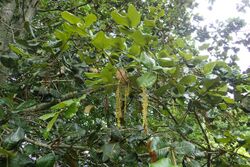Biology:Quercus semecarpifolia
| Quercus semecarpifolia | |
|---|---|

| |
| Scientific classification | |
| Kingdom: | Plantae |
| Clade: | Tracheophytes |
| Clade: | Angiosperms |
| Clade: | Eudicots |
| Clade: | Rosids |
| Order: | Fagales |
| Family: | Fagaceae |
| Genus: | Quercus |
| Subgenus: | Quercus subg. Cerris |
| Section: | Quercus sect. Ilex |
| Species: | Q. semecarpifolia
|
| Binomial name | |
| Quercus semecarpifolia Sm.
| |
| Synonyms[2] | |
| |
Quercus semecarpifolia is an Asian species of oak. It is native to the Himalayas and nearby mountains in Tibet, Afghanistan, India, Nepal, and Pakistan,[3] where it is referred to as kharsu.[4] It is classified in subgenus Cerris, section Ilex.[5][6]
Quercus semecarpifolia is an evergreen tree up to 30 metres (98 feet) tall. The leaves are up to 12 centimetres (4 3⁄4 inches) long, with a few teeth along the sides but rounded at the tip.[3][7] It has been grown in middle Europe, Western Germany, winter-hardiness zone 7, withstanding -14 °C, without any damages. It gives a good, showy bush to small tree with lush green leaves. The epithet semecarpifolia refers to a resemblance between the leaves of this species and those of Semecarpus anacardium.[7]
In its native range, it serves as a keystone species, exhibiting up to 80% dominance at elevations between 2700 and 3300 meters.[4] In areas where less degradation has occurred, Q. semecarpifolia reduces light at the forest floor, encouraging the growth of shade tolerant herbaceous species.[4] Local people make use of kharsu more frequently than other native oaks for food, animal fodder, fuel, and timber.[8] Its leaves are also known to support Antheraea proylei silk worms, goats,[9] and prevent slug infestations.[4]
Fossil record
Fossils of Quercus semecarpifolia have been described from the fossil flora of Kızılcahamam district in Turkey, which is of early Pliocene age.[10]
References
- ↑ Qin, H. (2020). "Quercus semecarpifolia". IUCN Red List of Threatened Species 2020. https://www.iucnredlist.org/species/194230/147633899. Retrieved 10 March 2023.
- ↑ "Quercus semecarpifolia Sm.". World Checklist of Selected Plant Families (WCSP). Royal Botanic Gardens (Kew). http://www.theplantlist.org/tpl1.1/record/kew-175022.
- ↑ 3.0 3.1 Huang, Chengjiu; Zhang, Yongtian; Bartholomew, Bruce, "Quercus semecarpifolia", Flora of China, 4, http://www.efloras.org/florataxon.aspx?flora_id=2&taxon_id=210001864
- ↑ 4.0 4.1 4.2 4.3 Rawat, Balwant; Rawat, Janhvi M.; Purohit, Sumit; Singh, Gajendra; Sharma, Pradeep Kumar; Chandra, Anup; Shabaaz Begum, J. P.; Venugopal, Divya et al. (2022). "A comprehensive review of Quercus semecarpifolia Sm.: An ecologically and commercially important Himalayan tree". Frontiers in Ecology and Evolution 10. doi:10.3389/fevo.2022.961345. ISSN 2296-701X.
- ↑ Denk, Thomas; Grimm, Guido W.; Manos, Paul S.; Deng, Min; Hipp, Andrew L. (2017) (xls). Appendix 2.1: An updated infrageneric classification of the oaks. doi:10.6084/m9.figshare.5547622.v1. https://figshare.com/articles/dataset/Appendix_2_1_________An_updated_infrageneric_classification_of_the_oaks/5547622/1. Retrieved 2023-02-18.
- ↑ Denk, Thomas; Grimm, Guido W.; Manos, Paul S.; Deng, Min; Hipp, Andrew L. (2017), "An Updated Infrageneric Classification of the Oaks: Review of Previous Taxonomic Schemes and Synthesis of Evolutionary Patterns", in Gil-Pelegrín, Eustaquio; Peguero-Pina, José Javier; Sancho-Knapik, Domingo, Oaks Physiological Ecology. Exploring the Functional Diversity of Genus Quercus L, Tree Physiology, 7, Cham.: Springer International Publishing, pp. 13–38, doi:10.1007/978-3-319-69099-5_2, ISBN 978-3-319-69099-5, https://doi.org/10.1007/978-3-319-69099-5_2
- ↑ 7.0 7.1 Smith, James Edward in Rees. 1814 The cyclopædia; or, Universal dictionary of arts, sciences, and literature. volume 29, pages not numbered, Quercus number 20
- ↑ Singh, Amit; Samant, S. S.; Naithani, Suneet (2021-09-01). "Population ecology and habitat suitability modelling of Quercus semecarpifolia Sm. in the sub-alpine ecosystem of Great Himalayan National Park, north-western Himalaya, India" (in en). South African Journal of Botany 141: 158–170. doi:10.1016/j.sajb.2021.04.022. ISSN 0254-6299. https://www.sciencedirect.com/science/article/pii/S0254629921001502.
- ↑ Raju, J.; Sahoo, B.; Chandrakar, A.; Sankar, M.; Garg, A. K.; Sharma, A. K.; Pandey, A. B. (2015-04-01). "Effect of feeding oak leaves (Quercus semecarpifolia vs Quercus leucotricophora) on nutrient utilization, growth performance and gastrointestinal nematodes of goats in temperate sub Himalayas" (in en). Small Ruminant Research 125: 1–9. doi:10.1016/j.smallrumres.2014.12.013. ISSN 0921-4488. https://www.sciencedirect.com/science/article/pii/S0921448815000048.
- ↑ Kasaplıgil, Baki (1977). "Ankara, Kızılcahamam yakınındaki Güvem köyü civarında bulunan son tersiyer kozalaklı-yeşil yapraklı ormanı" (in tr, en) (PDF). Bulletin of the Mineral Research and Exploration (Ankara: General Directorate of Mineral Research and Exploration) 88: 94-102. https://dergipark.org.tr/en/pub/bulletinofmre/issue/3914/52153.
External links
Wikidata ☰ Q7599286 entry
 |


